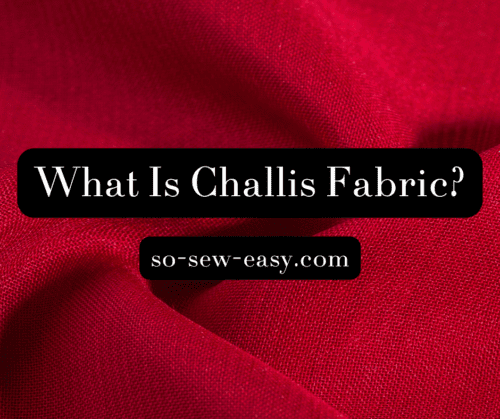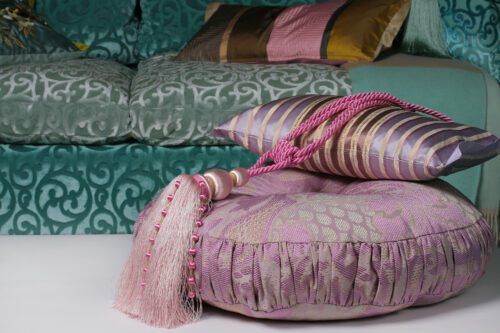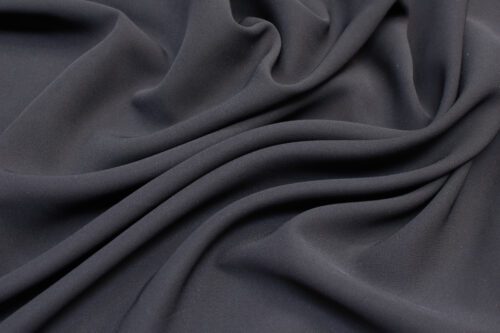
Challis (pronounced “shall-ee”) stands out as an incredibly versatile and popular fabric choice. As the world of fashion continually evolves, so does our understanding and appreciation of various fabrics. Today, we're exploring this fabric that you've probably come across but might not know by name.
Challis, a lightweight, soft, and drapey material, is known for its distinctively smooth, almost silky texture. Originally from France, the fabric boasts a unique blend of characteristics that make it a favourite amongst designers and home sewers alike. One of the unique aspects of challis is its flexibility in composition. Traditionally made from wool, modern challis can also be made from rayon, cotton, or a blend of various materials, all lending the fabric different weights and textures while maintaining its iconic drape and softness.
The History and Development of Challis
The history of Challis fabric dates back to 19th century France, specifically the 1830s, where it was first produced in the Lyon region, one of the major silk hubs in the world. Named after a local manufacturer, the fabric was initially made purely from high-quality worsted wool, creating a soft, draping material ideal for the era's elaborate clothing styles.
Interestingly, the name “Challis” was believed to be derived from an Anglo-Indian term, “Shallee”, which meant soft. A testament to the fabric's intrinsic characteristics and perhaps a nod to the global cross-pollination of textile practices.
As technology advanced, the textile industry saw a massive shift. With the Industrial Revolution, new weaving techniques and machinery were introduced, allowing for greater variety in fabrics and designs. Challis was no exception to this. In the late 19th and early 20th century, Challis began to be produced not only in wool but also in silk and cotton, making the fabric more versatile and affordable. The fabric soon gained popularity in both Europe and America.
With the advent of man-made fibers in the 20th century, Rayon Challis emerged. The softness and fluid drape of rayon perfectly emulated the desirable characteristics of the original wool Challis, but at a more economical price point and with greater resilience to heat and moisture. As a result, the use of Rayon Challis soared, particularly in the production of summer dresses, blouses, and scarves.
How Is Challis Fabric Produced?
It starts with selecting the right raw materials. The fiber composition of challis has evolved over time, including cotton, rayon, or wool, and sometimes blended fibers. Modern challis is frequently made from rayon due to its cost-effectiveness and similar properties to natural fibers like silk.
The chosen fibers are spun into yarn, which is then dyed according to the design requirements. Challis is known for its vibrantly printed or dyed patterns, so this stage is crucial for achieving the fabric's signature aesthetic.
The dyed yarn is then woven into fabric, typically using a plain weave. This kind of weave creates a fabric that is both strong and soft, with a surface that is smooth and somewhat lustrous, yet not as shiny as fabrics like satin.
Once woven, challis fabric undergoes a series of finishing processes. This includes washing and softening treatments to enhance its softness and drapability. Depending on the specific use of the fabric, additional finishing treatments may be applied, such as anti-shrink or wrinkle-resistant finishes.
What Are The Some Of The Uses Of Challis Fabric?
Challis fabric's inherent qualities – light weight, softness, and adaptability – make it a beloved choice in a plethora of commercial settings. Its vibrantly colored and often floral designs have made it a popular choice in women's apparel. It's widely used in crafting dresses, blouses, skirts, scarves, and pajamas, primarily for spring and summer collections due to its breathability.


In addition to clothing, challis has found its place in home décor. Its beautiful prints and inviting texture make it an excellent choice for items like pillow covers, lightweight curtains, and quilt backings.
Challis's print-friendly surface also means it's ideal for custom-printed designs, making it a favorite among designers and crafters alike. From a commercial standpoint, this allows manufacturers to offer a wide range of designs and color choices, catering to diverse consumer tastes and trends.
How To Tell Challis From Other Similar Fabrics
Understanding the differences between different types of fabric can be a daunting task. In this section, we'll outline for you what sets challis apart from five other similar fabrics: Crepe, Rayon, Chiffon, Satin, and Jersey.


Challis vs. Crepe
Crepe, unlike challis, has a distinctive crinkled or pebbled texture, created through high-twist yarns in both weft (horizontal) and warp (vertical) directions. Although it can be lightweight like challis, it often possesses a stiff and slightly rough texture. Challis, on the other hand, is characterized by its smooth and slightly lustrous surface, offering a soft and fluid drape ideal for clothing that requires movement and breathability.
Challis vs. Rayon
Rayon is often confused with challis because challis can be made from rayon. The key distinction is that rayon is a type of fiber, while challis is a type of fabric made by weaving these fibers together. Rayon challis, thus, has the same soft, lightweight, and drapable attributes of pure challis but with a more pronounced sheen.
Challis vs. Chiffon
Chiffon is a sheer, lightweight fabric typically made from silk or synthetic fibers like polyester. It is often used for evening wear and has a somewhat rough feel due to its twisted yarns. Challis is far more opaque, offering better coverage, and has a much smoother feel to the touch. It is also more versatile in terms of the types of garments it can be used for.
Challis vs. Satin
Satin is recognized for its glossy front and dull back, a result of its specific weave. This fabric is often heavier and more luxurious to the touch. Challis, while possessing a slight luster, lacks the high shine of satin. It is also lighter, more breathable, and offers a more casual appeal.
Challis vs. Jersey
Jersey is a type of knit fabric known for its stretchability, often used in casual or sportswear. Its elasticity differentiates it from challis, which is a woven fabric and thus doesn’t stretch the same way. Challis fabric provides a more flowing and graceful drape, perfect for a variety of dress styles, while still maintaining a casual, comfortable feel.
Best Sewing Projects Using Challis Fabric
Challis fabric has a reputation for being a delight to sew with, given its versatility, durability, and luxurious softness. This light, flowing fabric is perfect for a variety of sewing projects.
Dresses and Skirts
Challis is an ideal fabric for dresses and skirts because of its beautiful drape and lightweight feel. Whether you're sewing a maxi dress for the summer or a flared skirt for a night out, challis will help you achieve a flowing silhouette. The fabric's easy-to-sew nature makes it great for beginners who are just venturing into dressmaking.
Scarves and Shawls
Challis fabric’s softness and drape lend themselves perfectly to crafting cozy, stylish scarves and shawls. The breathability of the fabric ensures warmth without causing overheating, while its fluidity allows for beautiful, airy designs that make your accessories stand out.
Blouses and Tops
This fabric's gentle on the skin quality makes it an excellent choice for sewing blouses and tops. The lightweight nature of challis makes it comfortable to wear all day, and it works well for loose-fitting or flowy styles. With its diverse range of prints and colors, you can craft a myriad of unique designs to elevate your wardrobe.
Pajamas
If comfort is your utmost priority, then challis is a terrific choice for sewing sleepwear. Its softness and breathability make it an excellent choice for comfortable, dream-inducing pajamas that will help ensure a good night's sleep.
Curtains and Drapes
Beyond clothing, challis can be used for home decor projects like curtains and drapes. Its ability to drape beautifully makes it perfect for creating elegant, flowing window treatments.
Quilting
While not the most common use, challis can be incorporated into quilting projects for its unique texture and feel. It adds a soft, lightweight quality to quilted items, creating a different tactile experience compared to traditional quilting cottons.
Tips For Sewing With Challis Fabric
Working with challis can pose some challenges due to its drape and the fact that it can be slippery to handle. If you're planning on sewing with challis fabric, these tips will help you get the best results.
Dresses and Skirts
Challis is an ideal fabric for dresses and skirts because of its beautiful drape and lightweight feel. Whether you're sewing a maxi dress for the summer or a flared skirt for a night out, challis will help you achieve a flowing silhouette. The fabric's easy-to-sew nature makes it great for beginners who are just venturing into dressmaking.
Tip 1: Pre-Wash Your Fabric
Before you even begin cutting out your pattern, it's important to pre-wash your challis fabric. Challis can shrink significantly when it is washed for the first time. Washing it before you start your project can help prevent any future surprises after your garment is made. Wash the fabric using the same method that you will use for your finished garment. It's also recommended to dry it in the same way. After washing and drying, give the fabric a good press to ensure it's as smooth and wrinkle-free as possible before you start working with it.
Tip 2: Use Sharp Tools
One common challenge when sewing with challis is that it can be slippery and may fray at the edges. To combat this, it's essential to use sharp tools. A new, sharp rotary cutter or scissors will ensure you get clean, accurate cuts. Likewise, using sharp, fine pins will prevent the fabric from slipping as much when you are sewing. This is especially important for intricate parts of the pattern, such as corners or curves, where precision is key.
Tip 3: Stabilize Your Fabric
For parts of your pattern that need to hold their shape, consider using a stabilizer. Stabilizers come in several forms, including sprays and iron-on varieties. Applying a stabilizer can help your fabric hold its shape when you're working with it, making it easier to sew and giving your finished garment a professional look. For example, you might apply a stabilizer to the fabric you're using for a collar or button placket to help it maintain its structure.
Tip 4: Choose the Right Needle and Thread
When sewing with challis, it's crucial to choose the right needle and thread. A universal or sharp needle in size 70/10 or 80/12 is typically recommended. Challis is a relatively lightweight fabric, and using a too large or blunt needle could cause damage. In terms of thread, a high-quality cotton or polyester thread would be suitable. Remember that the color of the thread should match or blend with your fabric as closely as possible to ensure a seamless finish.
Tip 5: Use a Walking Foot
If you find that your fabric is still slipping too much while you're sewing, consider using a walking foot on your sewing machine. A walking foot is an attachment that helps to feed the fabric evenly through the machine, preventing it from bunching or stretching as you sew. This can be particularly helpful when sewing hems or other parts of your garment that need a smooth, straight finish.








I remember this fabric being extremely popular back in the 90s. Short skirts, maxi dresses, and palazzo style pants were everywhere. I agree that it could be a tricky fabric to work with and sharp tools definitely will be as important as pre-shrinking the fabric. It can fray or as you sew it may shift so any tip that helps working with challis is welcome.
This description of Challis will help when a lot when I go shopping for fabric. Thank you so very much for making this article available for print, PDF, etc.
It is my pleasure! Buying the right fabric is 50 percent the reason a project will fail or be a success the other 50 is fit.